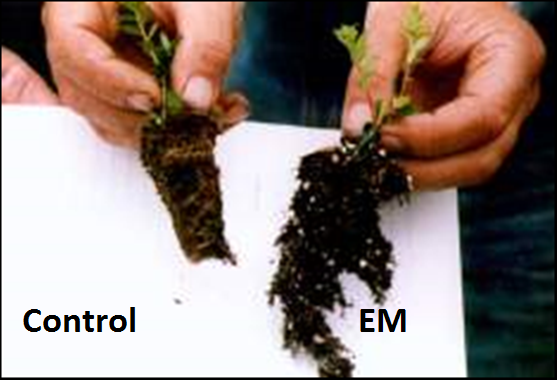The Rhizopshere is a dynamic and complex environment where microbes, plants, through their roots, and soil elements interact. This Rhizopshere with an abundance of life, is an environment rich in microbial diversity, and is physically, chemically and biologically different from soil deeper in the profile. It is this direct link between plant and microbes which makes this area so unique. The microbes in the rhizosphere are under direct influence of plant roots, which release organic material, mainly as root exudates. These exudates serve as substrates and food for the microbes. On the other hand, microorganisms associated with plant roots, either free or symbiotically living, help the host plant to adapt to stress conditions concerning water and mineral nutrition and soil-borne plant pathogens.
As many of you will know one of the associations between soil fungi and plant roots is called mycorrhizal activity. The establishment of mycorrhiza has a huge effect on the plant which then operates in an integrated approach with the fungi, thus promoting gains in adaptability and survival. The benefits of mycorrhizal colonisation to plant health, performance and survival are huge. Mycorrhizal fungi allow plants to draw more nutrients and water from the soil. They also increase plant tolerance to different environmental stresses. Moreover, these fungi play a major role in soil aggregation process and stimulate microbial activity. According to the plant species and to the growing practices and conditions, mycorrhizae provide different benefits to the plants and to the environment:
Mycorrhizal fungi can be difficult to establish and are notoriously susceptible to management issues such as heavy tillage, Agri-chem use, over fertilisation and overstocking. The establishment of mycorrhizal association is affected by other microorganisms of the rhizosphere, specifically by bacteria. There are a number of different bacterial strains which have a beneficial effect on colonisation and help to establish this plant-soil link. These bacteria are referred to as Mycorrhization Helper Bacteria (MHB), referring only to bacteria that promote the establishment of root-fungi symbiosis. Some of these MHB stimulate the process of mycorrhiza formation and others interact positively with the functioning of the already-established symbiosis.
How does EM affect Fungi-Soil Symbiosis?
 EM being a combination of Bacteria, Fungi and Yeasts will help the decomposition process of organic materials, and during fermentation will produce normally unavailable organic acids, such as lactic acid, acetic acid, amino acid, malic acid and bioactive substances and vitamins. These substances stimulate native microorganism populations and are known to promote plant cell division (growth).
EM being a combination of Bacteria, Fungi and Yeasts will help the decomposition process of organic materials, and during fermentation will produce normally unavailable organic acids, such as lactic acid, acetic acid, amino acid, malic acid and bioactive substances and vitamins. These substances stimulate native microorganism populations and are known to promote plant cell division (growth).
Secondly the diversity of microorganisms contained in EM and the metabolites they produce will increase the number and diversity of microorganisms in the soil. When microorganisms are activated, protozoans and larger organisms such as worms will increase in number and a healthier ecosystem will result. The stimulated microbes include Mycorrhizal fungi. We now know that three of the Bacteria in EM can be categorised as MHB. The interaction between these species and Mycorrhizal fungus impacts the following areas:
- The growth of beneficial Rhizosphere-associated micro-organisms
- Bacterial produced metabolites stimulate hyphal growth
- an enhanced production of the secondary metabolite auxofuran, which promotes the extension of the fungal mycelium
- The combination of antifungals produced by the one particular strain in EM provides a broad spectrum of antifungal activity that protects the mycorrhizal roots from fungal parasites, and selects against mycorrhizal fungal competitors.
Source link














